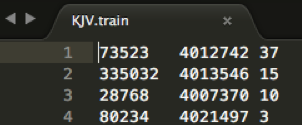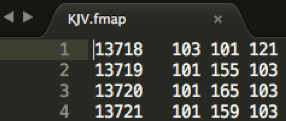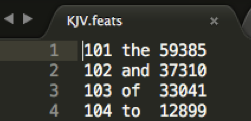Step 2. Featuring/Training

Now that we’ve preprocessed the text, we can proceed to breaking it down into units or features that can be compared (e.g. words, bigrams, trigrams). For this reason, this step is known as Featuring or Training. The chart below provides an overview of Featuring. TRACER can perform two types of featuring, Syntactic and Semantic. Syntactic dependency parsing is not always accurate because parsers (and the TRACER parser) are not yet able to infer dependencies. But if TRACER takes manually annotated data from treebanks, for example, then the parser would be able to produce usable results.

As you can see, there exists also a third type of Featuring implementation, Non-statistic Approaches. These aren’t part of TRACER. Among these, Verba dicendi featuring could be used for fragmentary texts but it’s not a stable feature; Surface Features, for example quotation marks, are also an unstable feature as they don’t always occur in historical texts; for Canonical References, please consult the research of Dr Matteo Romanello; for Signal Processing see Seo and Croft (2008).
Features
TRACER supports 10 different features or featuring units, from words as features to 10-gram features. Generally, features of 3-4 grams are sufficient for text reuse analyses. The n in 'n-gram' could be a character or a word.
- Word-based featuring: good for paraphrase detection. With this type of featuring one should also lemmatise and activate synonym replacement.
- Bigram featuring: good to detect verbatim and near-verbatim text reuse. Lemmatisation and synonym replacement with this N-gram approach might not work or be necessary.
- Trigram featuring: good to detect verbatim and near-verbatim text reuse. Lemmatisation and synonym replacement with this N-gram approach might not work or be necessary.
Feature density
The Selection step in TRACER asks users to define a Feature density for every detection task. By default TRACER sets the feature density to 0.5 (=50%), meaning that it will return only reuse pairs that are at least 50% similar or (share 50% of their features). For more information about Feature density, see Step 3. Selection.
Types of Featuring
Overlapping
An overlapping type of featuring is shingling, a process typically used to detect near-verbatim reuse. In NLP or text mining, a shingle is an n-gram and the process of shingling creates a sequence of overlapping tokens in a document. Below are some examples of shingling.
Example sentence: I have a very big house
Bigramshingling
(bigram = an n-gram of size 2)
(I have), (have a), (a very), (very big), (big house)
Feature 1 = I have
Feature 2 = have a
Feature 3 = a very
Feature 4 = very big
Feature 5 = big house
Trigramshingling
(trigram = an n-gram of size 3)
(I have a), (have a very), (a very big), (very big house)
Feature 1 = I have a
Feature 2 = have a very
Feature 3 = a very big
Feature 4 = very big house
Tetragram shingling
(tetragram = an n-gram of size 4)
(I have a very), (have a very big), (a very big house)
Feature 1 = I have a very
Feature 2 = have a very big
Feature 3 = a very big house
Shingling creates more and bigger features, so your detector will need more time to compute similarity.
Non-overlapping
A non-overlapping type of featuring is hash-breaking, a process typically used to detect duplicates or exact copies. Hash-breaking creates features with no overlap. Below are some examples of hash-breaking.
Example sentence: I have a very big house
Bigram hash-breaking
(bigram= an n-gram of size 2)
(I have), (a very), (big house)
Feature 1 = I have
Feature 2 = a very
Feature 3 = big house
Trigram hash-breaking
(trigram = an n-gram of size 3)
(I have a), (very big house)
Feature 1 = I have a
Feature 2 = very big house
Distance-based
The Distance-based Bigram can be used to improve retrieval performance. Distance-based bigrams are good for detecting paraphrases or reuse that is not 100% literal. The Distance-based bigram is a word pair whose distance between the two components is ≥ 1.
Example sentence: I have a big house
BigramI have 1 where 1 describes the distance between ‘I’ and ‘have’ (one word)have a 2 where 2 describes the distance between ’I’ and ’a’a big 3 where 3 describes the distance between ‘I’ and ‘big’big house 4 where 4 describes the distance between ‘I’ and ‘house’
Shingling or hash-breaking?
Let us assume you’re attempting to find the following string:
ABCDE
in the following reuse units:
GHABCDELMNABCDEXYZ
What would be the best algorithm to do so, shingling or hash-breaking? Let’s compare these two methods.
Hash-breaking
If we use hash-breaks of 2 features the similarity detection in string 2 won’t work because we break the reuse units the wrong way:AB CD E$NA BC DE XY Z$
As you can see, the AB feature in string 2 is split between NA and BC. For string 1, on the other hand, hash-breaking works:AB CD E$GH AB CD DE LM
In this case the breaks allow us to find the reuse.
Shingling
Both bigram and trigram shingling work to detect the example reuse above in strings 1 and 2. It doesn’t matter what method we use. What changes, however, is performance.
Customising parameters or properties
In TRACER, the featuring settings can be changed in the tracer_config.xml.

Let’s assume we want to change the above property in order to run trigram shingling on the text. The changed property will look like this:

We save the document and rerun TRACER. This reuse detection task produces a number of files, including:
KJV.meta
This file provides a human-readable overview of the trigram shingling training.

KJV.train
This file is organised as follows:FEATURE ID - REUSE UNIT ID - POSITION IN REUSE UNIT

KJV.fmap
This file provides a map or breakdown of each feature:FEATURE ID - WORD ID - WORD ID - WORD ID

KJV.feats
This document is the word index, where words are sorted by frequency:WORD ID - WORD - FREQUENCY

If you look at the Training default property in TRACER’s tracer_config.xml, you’ll notice that the trigram shingling training we’ve done is syntactic. TRACER also contains a semantic featuring property, immediately preceding the syntactic property (Figure below). This property is commented out by default but can be enabled by removing the comment syntax (<!-....->).

For semantic training, TRACER looks at words and co-occurrences.